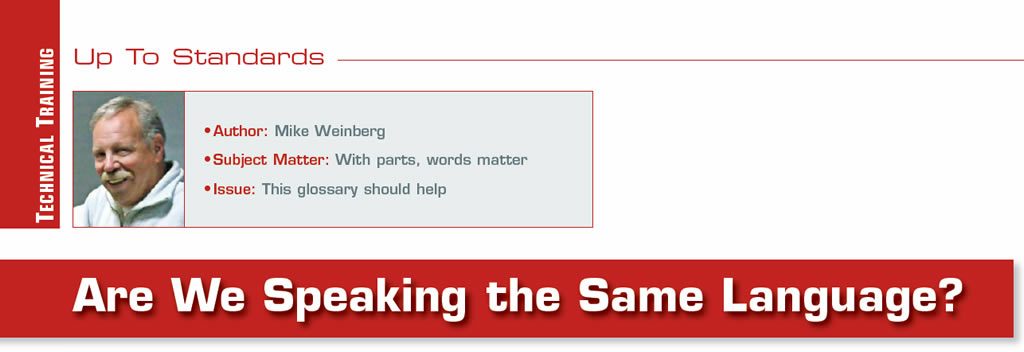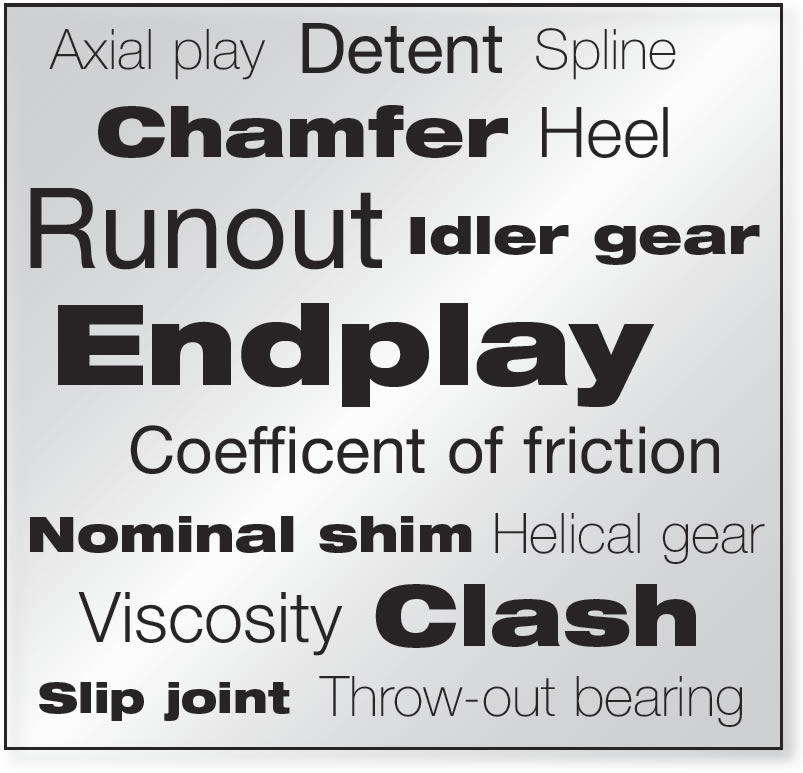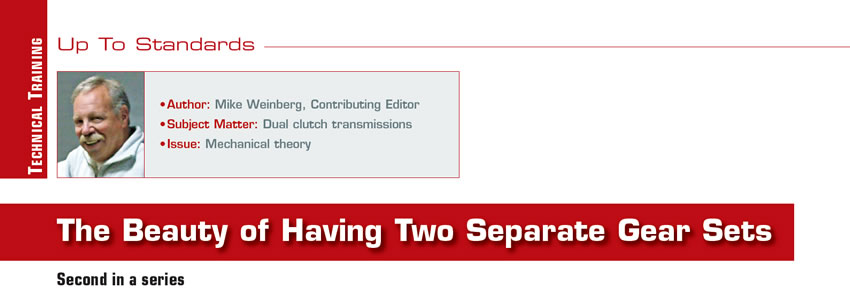
Up To Standards
- Author: Mike Weinberg
- Subject Matter: With parts, words matter
- Issue: This glossary should help
May I have a word with you, please?
If you are repairing transmissions for a living, you will invariably spend some time on the phone ordering parts and speaking with technical hotlines to assist in your diagnosis of problems. Having been on both ends of a tech line for over half a century and an equal amount of time buying parts, I have learned a whole new language. To be successful communicating with those entities, one must understand the language and be speaking about the same correct topic with whoever is on the other end of the conversation.

The problems are magnified by the fact that different manufacturers have different terminology (names or descriptions) for components. It is also necessary to understand the meaning of technical terms or measurements that you may be asked to make. This article will attempt to create a simple glossary of common terms related to the repair of manual transmissions, transfer cases and rear ends to try and make communication easier and more accurate.

All-wheel drive (AWD): a system engineered to transmit power to both sets of axles at the same time without any input by the driver of the vehicle. These systems can be always active or can have a disconnect by computer or other means, but will always function without the driver having to turn the system on.
Annulus gear: a ring or gear in which the teeth are internally cut used as one component of a planetary gear set.
Axial play: a measurement of movement that is parallel to the shaft or gear being measured. In other words endplay or the back-to-front movement of a shaft or gear.
Backlash: the amount of play or clearance between two gears in mesh.
Cardan joint: The common U joint named after a 16th century Italian mathematician.
Carrier: the section of the drive axle to which the ring gear is mounted containing the differential pinion and spider gears.
Center section: as above the differential carrier.
Chamfer: a beveled edge that brakes a 90-degree angle on a component such as a shaft or bore.
Clash: the noise that results when trying to mesh gears that are moving at different speeds. Proper synchronization of gear speeds is the function of the synchronizer assembly to eliminate clash.
Cluster gear: also called countershaft or lay gear. The gears that are machined or assembled on a single shaft which runs parallel and engages the speed gears on a typical main shaft.
Coast: when the throttle is lifted on a vehicle and it decelerates, the drive wheels are driving the transmission. Also, the side of the ring gear teeth that is under load while coasting.
Coefficient of friction: the amount of friction between two surfaces. Commonly used to specify correct fluid fill for wet clutch operated transmissions, transfer cases, and locking differentials.
Constant velocity joint: a joint found in drive shafts and axles that transmit power without changing shaft velocity. The common U joint will alter velocity of the shaft twice in one cycle. The different types of common CV joints are Rzeppa (6 ball), Birfield, Bendix (4 ball), and the Herrington or double
Cardan joint consisting of 2 U joints mated with a centering ball.
Damper: A component that reduces torsional or harmonic vibrations between the motor and the trans, or the drive shaft and the trans. A dual mass flywheel is one example.
Detent: a device used to locate a movable shaft in a specific location, such as a shift fork, usually a ball and spring with a ground slot on the shaft.
Differential: the center section of a rear end that allows the wheels on the drive axle to rotate at different speeds in a turn.
Direct drive: 1: 1 ratio of the input shaft and output shaft of a transmission.
Endplay: The amount of back and forth motion of assembled shafts that is parallel to the shaft. Also known as axial play.
Four-wheel drive (4WD): a system that transmits power to both axles of the vehicle and can be disconnected by the driver.
Heel: the end of the tooth on a ring gear that is furthest from the centerline.
Helical gear: a gear that has curved teeth cut on an angle. Helical gears have a thrust load where under power the gear train will try to move away from itself and the gears will contract under coast conditions during deceleration.
Idler gear: a gear meshed with two other gears to change direction of rotation, typically a reverse gear.

Independent suspension: a rear suspension (IRS) or a front suspension (IFS) where the elevation of the wheels can change independently.
Index: the need to align two mating parts in a correct order for assembly.
Input shaft: The gear that is mated to the clutch disc to transfer torque into the transmission. Also known as main drive gear, head gear or spigot gear.
Integral: formed permanently to the part such as a bell housing that is part of the main case casting.
Internal gear: A gear in which the teeth are cut into the inside of the gear pointing to the centerline.
Limited-slip differentials: posi traction, locker, all describe a rear-end differential that uses clutches or gears to put power to both drive wheels and limit the slip between axles under acceleration.
Mesh: two gears in which the teeth are interlocked.
Neutral: the point at which the input shaft is turning under power, but is disconnected from the output shaft.
Nominal shim: thickness established of a shim to begin the gauging point to measure from.
Overdrive: in overdrive conditions the output shaft will be turning faster than the input shaft through various sets of gears.
Pinion gear: a small gear that is meshed with a larger gear.
Powertrain: all of the components that transfer torque from the engine crankshaft to the driving wheels.
Propeller shaft: prop shaft is the drive shaft.
Runout: the amount of deviation in a component under rotation from the centerline.
Slip fit: a sliding fit for a component onto a shaft with no interference.
Slip joint: a yoke or sleeve that allows a drive shaft to change length.
Spline: grooves or slots in a bore or shaft that connects with a matching spline.
Spur gears: the teeth are cut straight across the gear parallel to the axis of the gear. Used infrequently in modern transmission due to noise, but they have no thrust load under power.
Throw-out bearing: also called a clutch release bearing.
Toe: the end of a ring gear tooth closest to the center line of the pinion gear.
U joint operating angles: The difference in angle between the U joint input and output shafts.
Viscosity: the resistance of a fluid to flow. The more viscous a fluid, the more it resists flow. This is the principal of a viscous coupling, where alternate splined discs shear through a fluid and the resulting heat thickens the fluid raising the viscosity level to that of a semi solid.
There are probably another hundred terms that I could list here, but these are the most common areas of missed communication which creates mistakes. Different components are called by different names in parts descriptions. Example: a drive and driven sprocket to transfer power from a chain in a transfer case may be called that by one OEM and a “chain gear” or “chain guide” by another. The point of this discussion is to recognize the different terminologies so that you are speaking the same language in your conversations with others.














